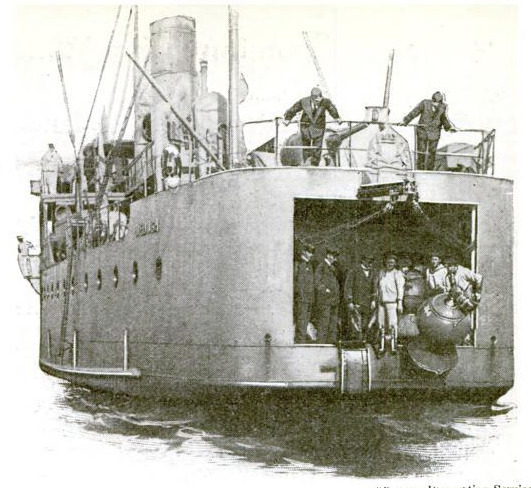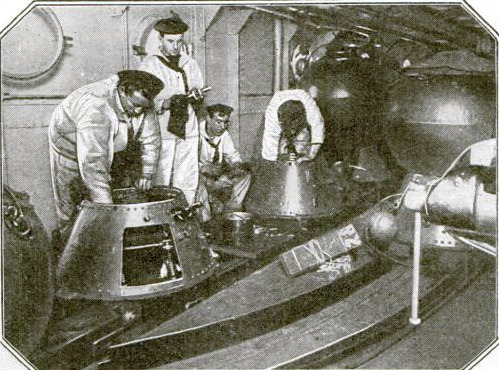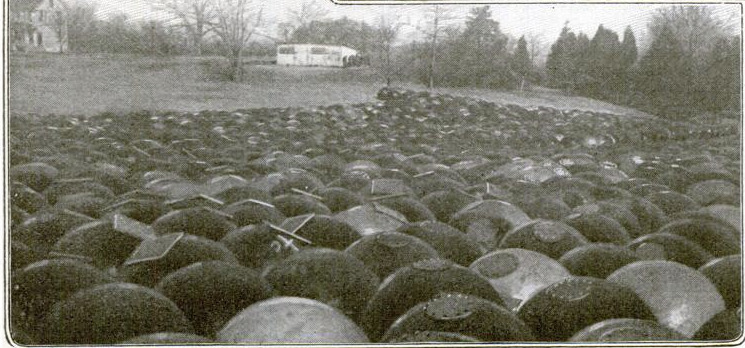The dangerous job of recovering the mines that are still in the Atlantic Ocean and in the North Sea
Item
-
Title (Dublin Core)
-
The dangerous job of recovering the mines that are still in the Atlantic Ocean and in the North Sea
-
Article Title and/or Image Caption (Dublin Core)
-
Title: They Are Still at War
-
Subtitle: Two milions deadly foes do not know peace has come
-
extracted text (Extract Text)
-
IN the North Atlantic and in the
narrow waters of the North Sea
are hundreds of thousands of the
deadliest foes who do not know that
peace has been declared. They are
the great army of mines, estimated at
two million, planted by the formerly
warring nations. Each one of these
mines carries the power to destroy the
greatest ship. To hunt them down
and rid the seas of them is, perhaps, a
more courage-trying job than any the
fighting men faced during the great
war.
What the Mines Are Loaded With
The cost of these mines in money
was tremendous—something like an
average of $1,000 for each of the two
million. The cost in lives cannot be
reckoned until the last is swept from
the seas. It is a job which, as one of
the world's greatest experts on sub-
‘marine mines told the writer recently,
“can never be prosecuted safely.”
It will be done by minesweepers such
as the one shown in the accompany-
ing photographs. Hundreds of these
‘mine - sweepers, equipped
with the most approved
apparatus for grappling and
raising mines, are manned
by thousands of men to
whom a sudden trip sky-
ward would be all in the day's
work.
T.N.T., an average of 200 pounds
of it to each one, is what the mines
are mostly loaded with, which means
that there is a total of about 25,000
tons of this terrific explosive to be
harvested. And harvested it will be;
for this undertaking is not a matter of
destroying the mines, but of salvaging
as many of them as possible. The ex-
plosives planted to kill are also useful
in the peace-time arts that help men
live; and then—well, the nations have
not disarmed yet.
Some of the mines will be cured of
their bite by time—those that depend
upon fulminate of mercury or similar
detonating compounds to set them off
when a ship strikes them deteriorating
quite rapidly and becoming unreliable
as death-dealers in about six months.
But there are great numbers of later
types so improved as to keep alive
no one knows just how long.
As long ago as the Russo-Japanese
war, when submarine mines
had not beenso perfected as to
give them the long life of those
afloat today, for a long time
after hostilities had stopped,
ships were sunk by mines
drifting about the Pacific.
Fortunately, the trend of the
currents in the North Sea,
where the vast mine-fields
were placed, is such that the
danger of large numbers of
mines getting into the main
steamship lanes is mot so
great as it would be other-
wise. Nevertheless, the dan-
ger is very real.
How They Are Raised
The photographs show two phases
of the work—raising the mines and
stowing them. Having grappled a
mine, the sweeper's crew hoists it
on board through the huge open port
in the stern. Then, along overhead
trolley tracks and flanged deck
tracks, the mines are moved to
their appointed places, with never
a jar.
The interior view shows the sailors
at work on mine anchors which con-
tain the automatically operated cable
windlasses that hold the mines at just
the right distance beneath the sur-
face to be most deadly. The mines
themselves can be seen hanging
from the overhead trolley.
-
Contributor (Dublin Core)
-
Press Illustrating Service (Image copyright)
-
Keystone View Co. (Image copyright)
-
Language (Dublin Core)
-
eng
-
Date Issued (Dublin Core)
-
1919-06
-
pages (Bibliographic Ontology)
-
71
-
Rights (Dublin Core)
-
Public domain (Google digitized)
-
Archived by (Dublin Core)
-
Davide Donà
-
Marco Bortolami (editor)
 Popular Science Monthly, v. 94, n. 6, 1919
Popular Science Monthly, v. 94, n. 6, 1919






